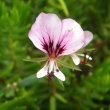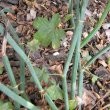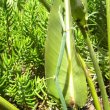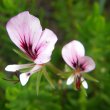Pelargonium tetragonum
| Botanical Name | Pelargonium tetragonum |
|||||||||||
| Family | Geraniaceae - The geranium family. |
|||||||||||
| Pronunciation | pe-lar-GO-nee-um tet-ra-GO-num |
|||||||||||
| Common Name(s) |
English: Square-stemmed pelargonium
|
|||||||||||
| Plant Group |
|
|||||||||||
| Plant Size |
|
|||||||||||
| Position |
|
|||||||||||
| General Information |
|
|||||||||||
| Specific Information | Pelargonium tetragonum is sought after by collectors for its unusual growth form, rather than for its garden usefulness. It is adapted to grow in arid habitats, making it an unusual specimen for a water-wise garden. The plant branches out from the base and tends to sprawl, unless supported by other vegetation, in which case it may reach a height of 2 meters. The succulent, jointed stems are three to four angled and almost leafless. When the hairy, palm-shaped leaves do appear, they remain on the stems for only a brief time before yellowing and falling off. |
|||||||||||
| Ad Break | ||||||||||||
| Flowers | ||||||||||||
| Description | pelargonium flower - the flowers occur in pairs, each with only four petals, the upper two petals being appreciably larger than the lower pair, and streaked with red or maroon |
|||||||||||
| Season |
|
|||||||||||
| Colour |
|
|||||||||||
| Growth Rate |
|
|||||||||||
| Plant Uses |
|
|||||||||||
| Distribution and Habitat | found only within a strip parallel to, but inland from the south-eastern coast of South Africa, extending from Worcester in the Western Cape to Grahamstown in the Eastern Cape, its distribution extending across both winter and summer rainfall climates, in semi-karoid scrub and dry, rocky spots |
|||||||||||
| Planting Suggestions | Pelargonium tetragonum is a dweller of arid habitats, and will rot if over-watered. The soil must be very well-drained and it does not need feeding. Plant in a sunny dry position, preferably in the light shade of a shrub through which it can climb, as it often does in its natural environment. Water sparingly until established, then seldom, if at all. In wetter climes it is better to keep this curious pelargonium in a pot or container. |
|||||||||||
| Medicinal Uses | No data found |
|||||||||||
| Ad Break | ||||||||||||










Comments
Pelargonium Tetragonum
I have one of these plants in my south-facing greenhouse in Leicester, UK.
It shared the bed with a thug of Passiflora Antioquiensis, which I just got rid of because it overwhelmed my space! I'm just wondering if the p.T. will do as well as before....It's had lots of water (tap & rain)over the 10 years I've had it, but on reading your site , I will give it much less.
The bed is of poor, stoney 'soil' and I was going to add some compost, now the Passiflora has departed, but assume you would not advise this? Before I read your advice, I gave it water & pruned it heavily, leaving the flower buds. to open. Hope to hear from you. Jenny Cook
Leave well alone?
Hi Jenny
Well it seems you have broken all the rules quite successfully so I am hesitant to suggest any changes. The stony soil is good and is probably what prevents water-logging, which would cause rot. A little feed of compost shouldn't do any harm as the plant has been in place for some years. I am interested in how well your plant flowers. Some plants from drier areas often do not flower as freely if they receive more water than they do in their natural habitat. If you do not get many flowers you could try reducing the water, especially during winter, to see if that encourages blooming. However, if the plant is thriving, you must be doing the right thing.
My own two specimens have been hit by a bug or disease. Many of the stems have completely dried out leaving just a few healthy bits and pieces. I am in the process of trying to save what is left. I feel quite envious when you say you have pruned yours!
I don't think the removal of 'the thug' should make a difference, but keep an eye on the plant just to make sure.
Kind regards
Lorraine
Discuss this plant
Share knowledge, ask a question or give an experience.